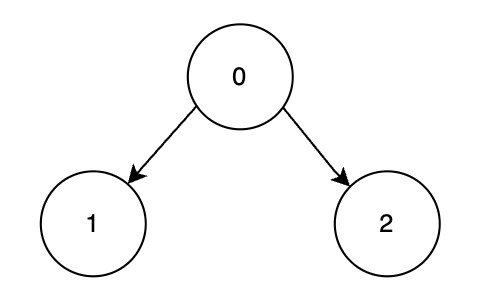Description
You are given a Directed Acyclic Graph (DAG) with n nodes labeled from 0 to n - 1, represented by a 2D array edges, where edges[i] = [ui, vi] indicates a directed edge from node ui to vi. Each node has an associated score given in an array score, where score[i] represents the score of node i.
You must process the nodes in a valid topological order. Each node is assigned a 1-based position in the processing order.
The profit is calculated by summing up the product of each node's score and its position in the ordering.
Return the maximum possible profit achievable with an optimal topological order.
A topological order of a DAG is a linear ordering of its nodes such that for every directed edge u → v, node u comes before v in the ordering.
Example 1:
Input: n = 2, edges = [[0,1]], score = [2,3]
Output: 8
Explanation:

Node 1 depends on node 0, so a valid order is [0, 1].
| Node | Processing Order | Score | Multiplier | Profit Calculation |
|---|---|---|---|---|
| 0 | 1st | 2 | 1 | 2 × 1 = 2 |
| 1 | 2nd | 3 | 2 | 3 × 2 = 6 |
The maximum total profit achievable over all valid topological orders is 2 + 6 = 8.
Example 2:
Input: n = 3, edges = [[0,1],[0,2]], score = [1,6,3]
Output: 25
Explanation:

Nodes 1 and 2 depend on node 0, so the most optimal valid order is [0, 2, 1].
| Node | Processing Order | Score | Multiplier | Profit Calculation |
|---|---|---|---|---|
| 0 | 1st | 1 | 1 | 1 × 1 = 1 |
| 2 | 2nd | 3 | 2 | 3 × 2 = 6 |
| 1 | 3rd | 6 | 3 | 6 × 3 = 18 |
The maximum total profit achievable over all valid topological orders is 1 + 6 + 18 = 25.
Constraints:
1 <= n == score.length <= 221 <= score[i] <= 1050 <= edges.length <= n * (n - 1) / 2edges[i] == [ui, vi]denotes a directed edge fromuitovi.0 <= ui, vi < nui != vi- The input graph is guaranteed to be a DAG.
- There are no duplicate edges.
Solution
Python3
class Solution:
def maxProfit(self, n: int, edges: List[List[int]], score: List[int]) -> int:
need = defaultdict(int)
fullMask = (1 << n) - 1
for x, y in edges:
need[y] |= (1 << x)
@cache
def dp(mask):
if mask == fullMask: return 0
res = 0
count = mask.bit_count() + 1
for node in range(n):
if (mask & (1 << node)) == 0 and (mask & need[node]) == need[node]:
res = max(res, dp(mask | (1 << node)) + count * score[node])
return res
return dp(0)
C++
class Solution {
public:
int recursion(int mask, int n, vector<int> &indegree, vector<vector<int>> &graph, vector<int> &score, vector<int> &dp) {
if(mask == (1LL << n) - 1) return 0;
if(dp[mask] != -1) {
return dp[mask];
}
// __builtin_popcount(mask) returns the total number of set bits in mask, which represents the current position in the ordering.
int count = __builtin_popcount(mask) + 1;
int ans = 0;
for(int i = 0; i < n; i++) {
// If the current node has not been visited and its indegree is 0 (following Kahn's Algorithm for Topological Sort),
// We then decrease the indegree of each of its child nodes by one.
if(!(1 & (mask >> i)) && indegree[i] == 0) {
int newMask = mask | (1LL << i);
for(auto &child: graph[i]) {
indegree[child]--;
}
ans = max(ans, count * score[i] + recursion(newMask, n, indegree, graph, score, dp));
// Using backtracking and again incrementing the indegree of each of its child nodes by one.
for(auto &child: graph[i]) {
indegree[child]++;
}
}
}
return dp[mask] = ans;
}
int maxProfit(int n, vector<vector<int>> &edges, vector<int> &score) {
int m = edges.size();
vector<vector<int>> graph(n);
vector<int> indegree(n);
for(int i = 0; i < m; i++) {
graph[edges[i][0]].push_back(edges[i][1]);
indegree[edges[i][1]]++;
}
vector<int> dp((1LL << n), -1);
return recursion(0, n, indegree, graph, score, dp);
}
};